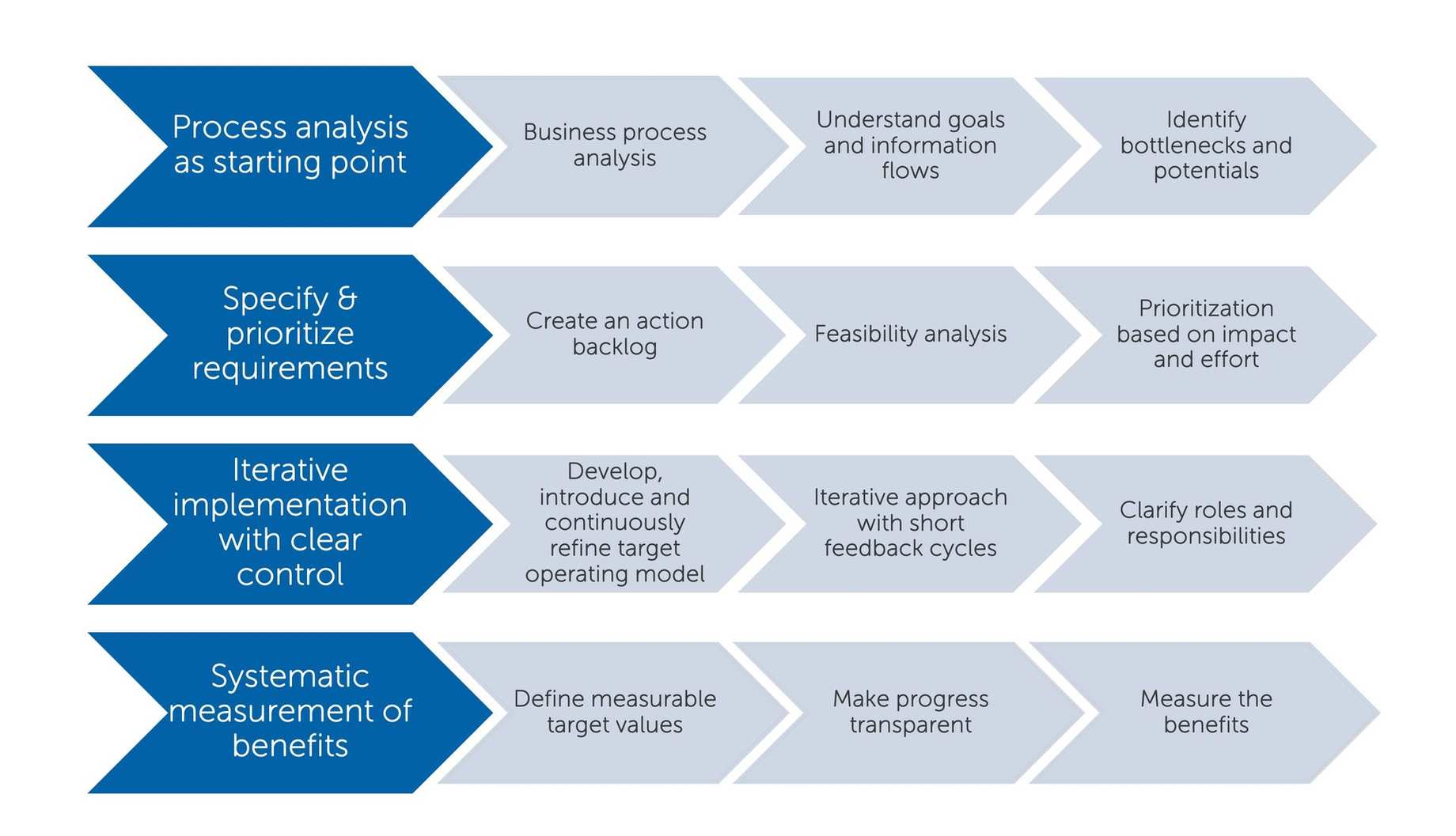Delivery capability
Process optimization through the targeted use of AI
Many companies are looking for ways to improve their processes in a targeted manner - using artificial intelligence (AI) as a lever for greater efficiency and cost optimization. But where to start? This is exactly where our support begins. With a structured approach - from process analysis to specifying and prioritizing requirements through to implementation - we help turn potential into concrete results. Our focus: using AI process optimization in such a way that measurable benefits are generated quickly.
Process analysis creates the basis for the targeted use of AI
In the first step, we analyze the relevant business processes together:
- What processes are in place?
- What goals are you pursuing?
- What information flows in or out?
This analysis creates a common understanding - and lays the foundation for deciding where process optimization through AI actually makes sense.
By specifying and prioritizing requirements for the Minimum Viable Product (MVP)
The analysis results in an initial backlog of measures - with requirements for which the use of AI appears to be particularly effective. These requirements are then refined together, checked for feasibility and prioritized according to impact and effort. This results in a clearly defined MVP that can be implemented at an early stage. This enables rapid learning and visible results - with a focus on feasibility, impact and a realistic starting point.
Implementation is managed transparently - with the right approach
Implementation is iterative, adapted to the complexity and framework conditions. With suitable management models, we ensure clear responsibilities, transparent progress and flexible adjustment options. Where it makes sense, we work in iterative sprints - so AI in processes does not become a major project, but a targeted implementation process with fast feedback cycles.
The benefits of process optimization through AI are systematically made measurable
A key success factor in process optimization using AI is the ability to prove the effect - both quantitatively and qualitatively. Right at the start of the project, we define measurable targets together: for example, reduced throughput times, error rates, costs per process or processing volume per day. These KPIs make progress visible and create transparency for stakeholders;
We also record qualitative effects - such as reducing the workload of teams or increasing customer satisfaction. In this way, AI not only makes efficiency tangible, but also verifiable.
From vision to implementation: using AI where it works
Not every process is equally suitable for optimization using AI. The following are particularly relevant:
- Document processing: e.g. automated extraction from forms or contracts.
- Invoice verification and accounting: structured recording, checking and approval.
- Customer support: e.g. through intelligent chatbots or email triage.
- Logistics and planning: Forecasting demand, routes or stock levels.
- Claims handling in the insurance industry: automatic checking and decision preparation for claims - with a high number of cases and recurring patterns, this is an ideal use case for AI.
Our experience is that wherever processes are rule-based, data-driven and high-volume, process optimization through AI can create significant added value.
Why wibas is the right partner for process optimization through AI
Sustainable AI process optimization goes far beyond technological issues. When AI is used in business processes, familiar procedures, responsibilities and often the self-image of teams change. Such changes are often met with resistance - an aspect that can make the difference between success and failure.
wibas has decades of experience in supporting change processes. As experts in transformation, wibas ensures that optimizations are not only planned but also implemented. Through professional Change Management succeeds in bringing people along, anchoring new ways of working and thus ensuring the long-term effectiveness of AI solutions in the company.
Secure case study: Optimization of claims management through AI
Do you want to know what potential lies in your processes? In an initial workshop, we will analyze the initial situation together and identify specific areas for action. Get in touch now - we look forward to working with you.
High performing organizations
The ability to deliver and customer focus are crucial characteristics for the success of any company. When teams and departments work together reliably and effectively, products and services are delivered on time. Read here which building blocks are relevant for this.
Leading deliverable organizations through change
Organizations in today's world need leaders who create the framework for delivery capability and customer orientation. In this training course, you will develop your leadership skills for a modern organization in a complex world.
AI-native change agent
This 3-day training course builds on the basic AI-Native Foundations course and deepens your knowledge of the successful use of AI in the company.
AI-Native Foundation
AI-Native Foundations - your introduction to working with AI. This two-day course provides individual knowledge and practical application of artificial intelligence. You will not only learn the language, prompting and how to use AI tools, but also how AI creates real value in the company.
Change Management
Our change management experts plan and orchestrate changes in order to successfully and sustainably implement the desired change, minimize risks and reduce resistance to change.

